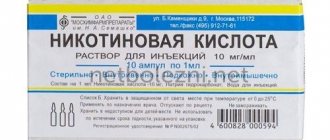Dyslipidemia (hyperlipidemia) itself is not a disease, but a pathological condition. According to statistics, it is diagnosed in every third inhabitant of the planet. In most cases, the reason lies in a violation of fat metabolism. Lipids themselves are not able to dissolve in water; in order to be transported to tissue cells, they create some kind of protein shell around themselves. Lipids in this state are called lipoproteins. Experts identify the following types of lipoproteins:
- Low density lipoproteins. They are formed in the internal organ of the digestive system - the liver from substances of the same name. These substances take part in the transport of compounds (triglycerides) to the cells of muscle and fatty tissues;
- Very low density lipoproteins. They are 60-70% triglycerides and contain a small amount of cholesterol;
- High density lipoproteins. They also originate in the liver. Their main task is to promote the removal of “bad” cholesterol from the body;
- Chylomicrons. These substances are synthesized in the walls of the small intestine. Their main purpose is to transport triglycerides to muscle and fat tissues.
In a person who does not suffer from cardiovascular pathologies, the above substances are in balance in the body. If the balance is disturbed, the number of lipids goes beyond the permissible limits. This leads to negative effects on the body. This condition provokes the future development of atherosclerosis. Atherosclerosis is a chronic pathology, the main symptom of which is the deposition of cholesterol and other fats in the form of plaques on the inner wall of the arteries. With this disease, the walls become denser and less elastic. It is recognized as the most common negative consequence of fat metabolism disorders. At the same time, experts distinguish two main groups of complications of this disease:
- Chronic. An atherosclerotic plaque leads to the appearance of stenosis of the lumen of the vessel. Given that the plaque in the vessels develops very slowly, the patient eventually develops chronic ischemia (a deficiency in the supply of nutrients and oxygen as a result of a significantly reduced blood flow) in the area of the blood supply to this vessel.
- Spicy. The occurrence of such complications is directly related to the development of thrombi (blood clots), emboli (blood clots that completely closed the lumen of the vessel), and vasospasm. This phenomenon leads to acute closure of the lumen of blood vessels, which causes the appearance of acute vascular insufficiency. As a result of the complication, the patient experiences a myocardial infarction, intestinal infarction, or ischemic stroke. In rare cases, doctors diagnose vascular rupture.
Causes
- Heredity.
- Hypothyroidism is a dysfunction of the thyroid gland.
- Diabetes.
- Obstructive liver diseases.
- Taking diuretics, immunosuppressants and other medications.
- Increased content of animal fats in food.
Provoking factors include a sedentary lifestyle, cholesterol abuse, alcohol intake, smoking, and a stressful personality type. The sooner a patient at risk contacts a lipidologist, the higher his chances of avoiding complications.
Diagnosis of pathology
At the initial stage, dyslipidemia can be detected by taking a blood test to measure the level of plasma lipids, lipoproteins and fat-like substances. In addition, there is an indicator (atherogenicity index), which is calculated in accordance with the content of total cholesterol and high-density lipoproteins in the blood. To establish an accurate diagnosis, they resort to careful diagnostic methods (in particular, laboratory and instrumental). Among them:
- careful history taking. During the initial examination, the doctor asks the patient in detail about all the symptoms that bother him, finds out who he works for, whether he has suffered from infectious diseases, and whether he has any relatives in his family who suffer from cardiovascular pathologies. The history may indicate vascular atherosclerosis, myocardial infarction or stroke not only in the patient himself, but also in his immediate family;
- physical examination. The pathology is accompanied by characteristic signs that can be seen visually. These include emerging xanthomas, xanthelasmas and lipoid arch of the cornea. During the examination, blood pressure is measured (it may be elevated). When listening to the heart, as a rule, there are no abnormalities with hyperlipidemia;
- general blood and urine analysis. Standard laboratory diagnostics are necessary in order to determine a possible inflammatory process and the presence of concomitant pathologies;
- blood chemistry. Unlike a general blood test, this diagnosis is more informative. It is used to determine the level of blood sugar and protein, as well as uric acid. This is necessary to identify concomitant damage to internal organs;
- immunological blood test. Through this study, the content of antibodies (proteins that can destroy not only foreign substances, but also cells of one’s own body) to pathogens (for example, chlamydia) is determined. In addition, the analysis allows you to determine the level of C-reactive protein - a protein whose level increases significantly due to the presence of an inflammatory process in the body;
- lipid profile (blood test for lipids). This is the main way to detect dyslipidemia. The resulting lipid profile will clearly show the value of triglycerides (esters of triglycerol with fatty acids), lipoproteins (high, low and very low density), and atherogenicity coefficient. These parameters will allow not only to establish a diagnosis, but also to identify other pathologies. For example, elevated triglyceride levels are diagnosed in patients with diabetes.
Principles of treatment of secondary dyslipidemia
If the disease develops against the background of another disease, it is very important to determine the original source and eliminate it. Complex therapy includes non-drug and drug methods.
Non-drug treatment
It is important for the patient to normalize body weight. For this purpose, he is prescribed dosed physical activity and a diet with limited animal fats. The diet must be enriched with vitamins and dietary fiber, and preference should be given to vegetables and fruits. It is mandatory to give up alcohol and smoking, otherwise other actions will be meaningless.
Drug treatment includes the following drugs:
- statins - to reduce cholesterol synthesis in the liver, to relieve inflammation;
- inhibitors of cholesterol absorption in the intestine;
- bile acid sequestrants;
- fibrates – to reduce triglyceride levels and increase high-density lipoprotein levels;
- Omega-3 polyunsaturated fatty acids.
Progressive lipidology specialists also practice extracorporeal methods indicated for severe forms of the disease. Genetic engineering methods have been developed for patients with a hereditary form.
Types of dyslipidemia
Signs of dyslipidemia directly depend on the type and stage of elevated lipid disorders. Experts divide them into the following types: congenital and acquired, isolated and combined. In accordance with lipids, the level of which is higher than normal, an isolated type is isolated when the level of cholesterol in the composition of lipoproteins is increased in the blood. The combined (mixed) type is characterized by an increase in blood not only cholesterol, but also triglycerides. From the point of view of etiology (origin), they are hereditary and acquired. The former are divided into monogenic, homozygous and heterozygous, and the latter into primary, secondary or alimentary.
Donald Fredrickson invented a slightly different classification, which was taken as the basis for the international standard nomenclature of hyperlipidemias. He identified 5 main types of pathological conditions. Below is a table with the main characteristics of each type.
| Type name | Plasma TC | Specifics of the underlying disorder | The degree of risk of developing atherosclerosis |
| I; | Increasing; | In liquid tissue, only the number of chylomicrons (CM) is increased; | Absent (no proven connection with atherosclerosis); |
| IIa; | Increasing; | In liquid tissue, the number of only low-density lipoproteins (LDL) is increased; | Very high; |
| IIb; | Increasing; | In liquid tissue, the number of low density lipoproteins (LDL), very low density lipoproteins (VLDL) and triglycerides (TG) is increased; | Very high; |
| III; | Increasing; | In liquid tissue, the number of intermediate density lipoproteins (IDL) is increased; | High; |
| IV; | Within normal limits; | In liquid tissue, the number of very low density lipoproteins (VLDL) is increased; | Average; |
| V. | Increasing. | In liquid tissue, the number of very low density lipoproteins (VLDL) and chylomicrons (CM) is increased. | Low; |
Prevention
If left untreated, dyslipidemia leads to atherosclerosis with chronic and acute complications. In the first case, chronic ischemia develops in the area of the blood supply where an atherosclerotic plaque has formed. In the second - acute vascular insufficiency due to the closure of the lumen of blood vessels, and then infarction of various organs.
The prognosis depends on the localization of atherosclerosis, the rate of development of changes and provoking factors that can be influenced. It is very important to normalize body weight and adjust your diet, give up bad habits and emotional overload, and switch to a physical activity program on an individual schedule.
Specialists from Professor Gorbakov’s Clinic will talk about these and other preventive methods with which you can maintain your health and prevent serious consequences.
Clinical picture
It is immediately worth noting that at first the disease may not manifest itself in any way. Sometimes its symptoms are similar to those of cardiovascular diseases, including coronary artery disease. But with an increased content of fats in the blood, one can still notice the distinctive features of the pathology. Many people suffering from this disorder report the following symptoms of dyslipidemia:
- xanthoma formation. These are compacted nodules that form on the tendons. They are filled with cholesterol;
- the appearance of xanthelasma. In this case, the seals are located under the skin of the eyelids. They are characterized by a yellowish color;
- formation of a lipoid arch of the cornea. It is represented by a white or yellowish edging. It is observed mainly in patients 50 years of age and older who have a genetic predisposition to impaired fat metabolism;
- xanthomatous rash. It covers the entire body.
Additional symptoms of the disease include the appearance of excess weight and increased blood pressure. People are also diagnosed with hyperglycemia and impaired hemostasis.
Dyslipidemia: challenges to reducing cardiovascular risk
Dyslipidemia is a global health and economic problem and a key risk factor for cardiovascular disease. Lipid-lowering therapy is associated with a reduced risk of major cardiovascular events. Target lipid levels to be achieved during therapy depend on the underlying cardiovascular risk. When prescribing statins, be aware of the potential increase in the risk of type 2 diabetes. The issue of prescribing statins to patients over 75 years of age as primary prevention remains open. Within the framework of the XXVI Russian National Congress “Man and Medicine” and the III Cardio Summit (April 8–11, 2021, Moscow), experts discussed issues of reducing cardiovascular risk. The particular interest of practicing physicians in this topic is due to the frequent use of patients for primary medical care and the difficulties of correcting lipid disorders.
Relevance
Dyslipidemia is traditionally considered as one of the leading factors in the pathogenesis of cardiovascular diseases (CVD) and makes a significant contribution to overall mortality. According to the NHANES study, in the United States the prevalence of dyslipidemia reaches 53%, increased levels of low-density lipoprotein cholesterol (LDL-C) are observed in 27% of cases, triglycerides in 30%, and decreased levels of high-density lipoprotein cholesterol (HDL-C) in 23%1. According to domestic data, the prevalence of hypercholesterolemia in Russia is 58.4%, increased levels of LDL cholesterol are recorded in 59.7% of cases, and decreased levels of HDL cholesterol are recorded in 19.5%2.
Dyslipidemia is an important economic problem. According to the 2021 analysis, the total economic damage from hypercholesterolemia in the Russian Federation is at least 1.29 trillion rubles. per year, which is equivalent to 1.5% of GDP. However, direct costs, including the costs of the health care system and disability benefits, account for only 2.3% of the damage. At the same time, 97.7% are losses in the economy due to premature mortality and decreased labor productivity3.
Experts from the World Health Organization note that three main risk factors make the greatest contribution to the risk of sudden death: arterial hypertension, hypercholesterolemia (dyslipidemia) and smoking.
Determination of cardiovascular risk
It is important for the clinician to understand what risk category the patient belongs to. Patients with documented atherosclerotic CVD, type 1 or 2 diabetes mellitus (DM), very high levels of individual risk factors, or chronic kidney disease (CKD) are automatically at very high or high overall risk for developing CVD. As a rule, in such patients the risk of developing probable fatal events is not determined, but active correction of all risk factors is immediately carried out. In other cases, it is recommended to use special systems, such as the SCORE scale, to assess the overall risk of developing CVD. The fact is that many patients with several risk factors may be at high cardiovascular risk. As is known, the SCORE scale evaluates the probability of developing the first fatal atherosclerotic event in the next ten years.
In September 2021, updated recommendations from the European Society of Cardiology and the European Atherosclerotic Society on the management of patients with dyslipidaemia were presented. The new European guidelines introduce a modified SCORE scale. The new version includes an age of 70 years, and also excludes the total cholesterol value of 8 mmol/l, since its presence already implies a high risk4.
The SCORE scale allows you to categorize patients according to their cardiovascular risk - very high, high, moderate and low. So, a very high risk involves:
- registered clinical CVD;
- a history of myocardial infarction, acute coronary syndrome, coronary artery revascularization (percutaneous coronary intervention or coronary artery bypass grafting);
- previous ischemic stroke or peripheral vascular disease;
- CVD confirmed by coronary angiography, radionuclide imaging, stress echocardiography, ultrasound examination of the carotid arteries;
- Diabetes with target organ damage (for example, proteinuria) or the main risk factor - smoking, arterial hypertension, dyslipidemia;
- early-onset type 1 diabetes, lasting over 20 years;
- Severe CKD (glomerular filtration rate 2);
- ten-year risk of fatal CVD by SCORE ≥ 10% and familial hypercholesterolemia with atherosclerotic CVD or at least one major risk factor.
Patients classified as high risk include:
- with an increased level of one of the risk factors, in particular the level of total cholesterol > 8 mmol/l, LDL cholesterol > 4.9 mmol/l or blood pressure ≥ 180/110 mmHg. Art.;
- familial hypercholesterolemia without other major risk factors;
- DM, but without target organ damage, as well as with DM lasting ≥ 10 years and another additional risk factor;
- moderate CKD (glomerular filtration rate – 30–59 ml/min/1.73 m2);
- ten-year risk of fatal CVD according to SCORE ≥ 5% and
The category of patients at average risk consists of young patients with diabetes (4.
According to the latest European guidelines, factors modifying the SCORE risk score include social deprivation, obesity and central obesity (defined using body mass index (BMI) and waist circumference, respectively), physical inactivity, psychosocial stress, family history of premature CVD (men 4 .
New targets for lipid-lowering therapy
At the “Man and Medicine” congress, issues of primary and secondary prevention in the aspect of dyslipidemia were discussed. Russian and foreign guidelines on reducing blood cholesterol levels to reduce atherosclerotic cardiovascular risk in adults emphasize the importance of correcting LDL cholesterol levels to prevent CVD. This recommendation is based on evidence-based medicine. Thus, according to the results of a meta-analysis of 27 randomized trials involving 174,179 patients, a decrease in LDL cholesterol by 1 mmol/l is associated with a reduction over five years in major vascular events by 21%, major coronary events by 24%, percutaneous coronary intervention by 24%, stroke of any etiology by 15%, ischemic stroke by 21%, cryptogenic stroke by 13%, vascular death by 12%, coronary death by 20%, non-coronary cardiac death by 8%5.
What target LDL cholesterol levels should be achieved in patients of different cardiovascular risk?
In the 2021 European guidelines for secondary prevention in very high-risk patients, LDL cholesterol level was considered as a target
The changes did not affect the LDL cholesterol target. It is 4.
In addition, CVD prevention includes:
- to give up smoking;
- a diet low in saturated fat with an emphasis on grains, vegetables, fruits and fish;
- 3.5–7 hours of moderate physical activity per week or 30–60 minutes per day;
- BMI 20–25 kg/m2, waist circumference
- blood pressure level
- Non-HDL-C (as an additional target)
- apoprotein B (apoB) (as an additional target)
- HbA1c 4.
Triglycerides are not the target of therapy, but level 4.
At the Man and Medicine Congress and the III Cardio Summit, lifestyle modification measures that have proven effective both in the general population and in individuals at high cardiovascular risk were discussed in detail.
ApoB concentration may serve as a marker of atherogenicity of plasma lipoproteins, especially in patients with hypertriglyceridemia and normal LDL cholesterol levels, since apoB levels above 150 mg/dL are closely associated with increased cardiovascular risk.
In the 2021 European guidelines, apoB assessment was only provided as an alternative risk marker primarily in patients with hypertriglyceridemia. In the new recommendations, apoB strengthened its position. It is now recommended for use in cardiovascular risk stratification in patients whose risk is underestimated using LDL cholesterol alone. This refers to patients with diabetes, obesity, hypertriglyceridemia and very low LDL cholesterol levels.
Several studies have demonstrated that for some population groups, despite achieving target LDL cholesterol levels with adequate lipid-lowering therapy, a high risk of cardiovascular complications remains - 60-80%. This risk is defined as residual. According to modern concepts, one of the main factors influencing the residual risk in patients with atherogenic dyslipidemia, along with increased levels of triglycerides and reduced levels of HDL cholesterol, is lipoprotein (a)6. The 2021 European guidelines recommend measuring lipoprotein(a) levels at least once in every adult's life. Patients with extremely high lipoprotein(a) levels > 180 mg/dm (> 430 mmol/L) have a lifetime risk of developing atherosclerotic cardiovascular events identical to that of patients with familial heterozygous hypercholesterolemia. In 90% of cases, very high levels of lipoprotein (a) are genetic.
"Pitfalls" of lipid-lowering therapy
One recently published study addressed the issue of achieving target lipid levels during statin therapy. The prospective cohort study included 165,411 patients receiving statins for primary cardiovascular prevention. According to the analysis, the optimal reduction in LDL cholesterol in response to statin therapy was observed in only half of the patients7.
During the “Man and Medicine” congress, the safety of statins was discussed, including in the context of an increased risk of developing diabetes. A number of epidemiological studies have shown an association between statin therapy and the development of diabetes mellitus. Thus, in a Dutch population-based study involving 9535 patients over 45 years of age without diabetes at the time of inclusion in the study, statin use was associated with a 38% increase in the risk of developing type 2 diabetes. Patients with impaired glucose homeostasis and those with overweight/obesity were at higher risk of developing the disease8.
In a recently published meta-analysis of 20 studies (18 cohort and two case-control), the relative risk of developing diabetes was significantly higher by 44% in those receiving statins9.
According to an analysis by the Diabetes Prevention Program (DPP), the risk of new cases of diabetes increases by 36% during statin therapy in patients with prediabetes. Duration of statin therapy is associated with the risk of diabetes (p = 0.007). Moreover, the risk of diabetes does not depend on the level of reduction in LDL cholesterol10.
At the scientific sessions of the “Man and Medicine” congress and the III Cardio Summit, experts analyzed the prescription of lipid-lowering therapy for patients over 75 years of age.
The ALLHAT-LLT trial and a meta-analysis of two large trials, JUPITER and HOPE-3, in older patients, have questioned the benefit of statin therapy for primary prevention in people over 75 years of age. The ALLHAT-LLT study included 2867 patients over 65 years of age with hypertension but no indication of atherosclerotic CVD. Pravastatin therapy was not associated with an improvement in all-cause mortality11.
The JUPITER study initially enrolled 17,802 patients of both sexes without CVD, with 5,695 participants aged ≥70 years. Therapy with rosuvastatin 20 mg did not significantly reduce the risk of overall death. A high rate of refusal of rosuvastatin therapy was recorded in elderly people - 17% in the group from 65 to
The HOPE-3 study examined the effectiveness of rosuvastatin 10 mg in 12,705 persons without CVD at average cardiovascular risk. 3086 participants were aged 70 years or older. Statin therapy did not lead to a statistically significant reduction in either the composite endpoint of death from cardiovascular causes, nonfatal myocardial infarction and nonfatal stroke, or overall death12.
More recently, a meta-analysis of 28 studies involving 187,000 patients, 14,500 (8%) of them aged 75 years or older, was published. It has been shown that in patients 75 years of age and older, the use of statins as primary prevention does not lead to a significant reduction in major adverse vascular events13.
A large retrospective analysis was recently published based on data from more than 46,000 patients aged 75 years and older without clinically significant atherosclerotic CVD. It has been established that in patients 75 years of age and older without diabetes, statin therapy does not reduce the incidence of atherosclerotic diseases and all-cause mortality. There is also no benefit from statin therapy in patients over 85 years of age with diabetes14.
Monitoring laboratory parameters during lipid-lowering therapy
Before prescribing lipid-lowering therapy and during it, it is necessary to monitor lipid and enzyme levels. Recent guidelines for dyslipidemia require at least two tests, one to two weeks apart, before initiating lipid-lowering therapy, except for conditions requiring immediate treatment (eg, acute coronary syndrome or very high-risk patients). Response to therapy should be assessed 8 ± 4 weeks after initiation of medications, and 8 ± 4 weeks after changes in therapy until target control values are achieved4.
After reaching the target or optimal cholesterol level, lipid levels are monitored once a year (unless there are problems with following the doctor's instructions or there are other reasons for more frequent testing). It is advisable to assess alanine aminotransferase (ALT) before starting treatment, 8–12 weeks after starting drug therapy, or after any increase in drug dose. Routine ALT monitoring is not indicated during statin therapy.
Traditionally, lipid metabolism indicators are determined on an empty stomach. However, recent studies demonstrate that for most measures the differences between fasting and postprandial measurements are very small. For example, in many studies, nonfasting triglyceride levels exceeded fasting values by ~0.3 mmol/L. For most patients, this increase is not clinically significant. Therefore, a number of guidelines provide for the determination of triglycerides in a non-fasting state. Calculated LDL cholesterol levels should be interpreted with caution when lipid levels are not measured in a fasting state.
In 2021, results of a study of the association between cardiovascular events and lipid levels measured in fasting and non-fasting conditions in the same patients were published15. The post-hoc prospective study included patients who had previously participated in the randomized ASCOT-LLA trial. Study participants had fasting and non-fasting lipids measured at four-week intervals. In terms of association with the development of coronary and atherosclerotic cardiovascular events, the results of measuring lipid levels in fasting and non-fasting conditions were the same. However, the consistency of fasting and non-fasting lipids allowed patients to be properly classified into CVD risk categories (95% of cases).
Conclusion
Dyslipidemia is a global health and economic problem and a key risk factor for cardiovascular disease.
As part of the “Man and Medicine” congress, clinical algorithms for the management of patients at the stage of primary health care were tested for hypercholesterolemia, as well as arterial hypertension, stable coronary heart disease, dyspepsia, non-alcoholic fatty liver disease, tobacco addiction, and type 2 diabetes mellitus. type, acute and recurrent cystitis, acute otitis media, acute and recurrent tonsillopharyngitis, acute bronchitis, acute and chronic rhinosinusitis and vaccine prevention. All approved algorithms are currently available for use in clinical practice.
Signs of lipid metabolism disorders
In most cases, there are no signs of dyslipidemia, and it is detected by examining the blood when a patient visits for high blood pressure , heart pain , dizziness , etc. That is, the patient is examined already when the first manifestations of vascular atherosclerosis . With atherosclerosis of the vessels of the legs, pain in the legs appears when walking, and with atherosclerosis of the vessels of the brain - memory impairment, headaches and dizziness.
pancreatitis appear - bloating, mushy stools, heaviness and pain in the left hypochondrium or girdle pain. This is due to the fact that toxic products arising from the hydrolysis of large amounts of triglycerides affect the pancreas. An excess of chylomicrons causes microthrombosis in any organ. Triglycerides are deposited in the cells of the reticulohistiocytic system, so the spleen and liver enlarge. Ultrasound reveals fatty hepatosis (fatty liver), which is also a consequence of lipid metabolism disorders and often occurs without symptoms.
Characteristic skin changes are observed in hereditary hyperlipidemias.
- Flat xanthomas . These are yellowish stripes in the folds of the fingers and palms.
- A significant increase in triglyceride levels leads to the appearance of eruptive xanthomas . These are multiple nodular or spherical formations of yellow color, sometimes with a pink corolla. These elements are found throughout the body, but are more often detected on the back, buttocks, chest, elbows and knees.
- Most often, this skin pathology occurs in individuals with decompensated diabetes mellitus and severe triglyceridemia .
- Tendon xanthomas are yellowish nodules that form in the area of the tendons on the hands, in the area of the elbow joint and the Achilles tendon. Tendon xanthomas are a sign of familial hypercholesterolemia.
- Xanthelasma is a deposit of cholesterol under the skin of the eyelids in the form of flat yellow plaques. Xanthelasmas occur in biliary cirrhosis with normal lipid levels.
- The lipoid arch of the cornea appears as a white rim along the edges of the cornea. Its appearance at a young age indicates hereditary dyslipidemia.
Eruptive xanthomas
Xanthelasmas
With severe hypertriglyceridemia, the arteries and veins of the retina are creamy white.
Lipoid arch
General information
Lipids are organic substances in the body. Blood lipids are represented by cholesterol, fatty acids, triglycerides and phospholipids. Triglycerides accumulate in adipose tissue and provide energy. Cholesterol is produced in the liver and is necessary for the synthesis of hormones, membrane formation and bile acid synthesis. Phospholipids are part of cell membranes. Cholesterol and triglycerides are present in the blood in the form of a complex with proteins and are called lipoproteins (fat + protein). Lipoproteins transport lipids to organs and tissues, where they are used for their intended purpose. Liproteins are divided into:
- chylomicrons;
- very low density lipoproteins;
- low density;
- intermediate density;
- high density.
They all have different densities and sizes. About 75% of cholesterol is in LDL (the main atherogenic lipoprotein), and triglycerides are in chylomicrons. Catabolism of low-density lipoproteins occurs in peripheral tissues. 70-80% of low-density lipoproteins are removed from plasma every day, and the rest is taken up by cells. With normal lipid metabolism in the blood, the physiological level of essential lipids is determined. Violations of lipid metabolism lead to the development of atherosclerosis , against which cardiovascular diseases develop (coronary artery disease , hypertension , myocardial infarction and stroke ). A direct connection has been established between cholesterol levels and cardiovascular diseases and their complications. A manifestation of lipid metabolism disorders is dyslipidemia or hyperlipidemia .
What is dyslipidemia? This is a violation of the normal ratio of blood lipids (fats). Hyperlipidemia is a congenital (primary) or acquired (secondary) increase in the level of certain blood lipids, and since lipids in the blood are associated with transport proteins (lipoproteins), the term hyperlipoproteinemia is used. Typically, dyslipidemia, hyperlipidemia and hyperlipoproteinemia are identified. One way or another, these terms reflect the essence of one pathological process - increased levels of cholesterol, triglycerides and decreased levels of high-density lipoprotein cholesterol. The diagnosis of dyslipidemia is not independent, but is included in the clinical diagnosis of the underlying cardiovascular disease.
Hyperlipidemia occurs in 50-60% of adults and is an important factor in the development of cardiovascular diseases and a cause of increased mortality. Among patients with high levels of low-density lipoprotein, mortality is significantly higher. LDL contains the protein apolipoprotein B. Considering the importance of apoB-containing lipoproteins in the development of atherosclerosis, it is important to determine these particular lipoproteins to assess the risk of cardiovascular diseases. Elevated triglyceride levels also pose a risk of developing cardiovascular disease. The increasing prevalence of cardiovascular diseases necessitates the establishment of risk groups for patients, early detection and treatment of lipid metabolism disorders. Normalization of lipid parameters is the main task, the implementation of which reduces cardiovascular risk. The code for dyslipidemia according to ICD-10 is extensive - from E78.0 to E78.9 (the type of disorders is specified in the subheadings).
Hyperlipidemia: treatment
The most important thing in the treatment of hyperlipidemia is to find and remove the causes that provoked an increase in the level of fat in the body. Diet and lifestyle correction are one of the key conditions for successful treatment. We will talk about how to eat and what kind of lifestyle is preferable to lead below, but now we’ll talk about drug treatment of hyperlipidemia.
Drug treatment
As a rule, in the early stages of hyperlipidemia, it is enough to adjust your diet and lifestyle to normalize the level of fat in the body. Medicines are usually prescribed to people who have not responded to diet therapy during the first month of treatment. What medications can our specialists prescribe for you:
- Statins
- Fibrates
- Vitamin B5 or niacin
- Drugs that bind bile acids
Our specialist will select all medications strictly individually, based solely on your situation. It is important to remember: treating hyperlipidemia is not a one-time measure. If your body has a tendency to this disease, therapy must be carried out constantly: eat right, lead a correct lifestyle and, if necessary, adjust the level of fat in the body with medications. Please note: one of the key reasons to choose treatment for hyperlipidemia in our network of clinics is the opportunity to cleanse blood vessels of excess cholesterol using high-tech methods of gravitational blood surgery.






